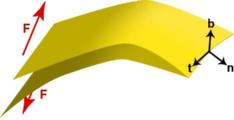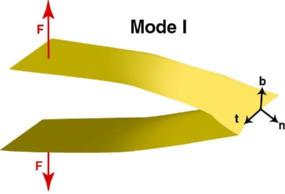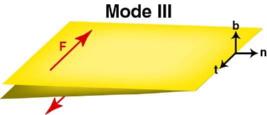
In physics, we often use symmetry to break down a complicated linear problem
into small pieces. The elastic deformations around a crack turn out to be
a nice example of this method, with an interesting feature. Jennifer
Hodgdon pointed out to me that we can understand
Mode I, Mode II, and Mode III fracture using two symmetries of a straight
crack front.

At the left, you see a growing crack. Although the crack can be curved in various ways, very close to the edge of the crack we can approximate it as a straight crack edge along a vector t, with a crack surface perpendicular to a vector b. The vector perpendicular to these two, pointing in the direction of crack growth, we call n.
There are two symmetries of the crack in this approximation.
| Rb | Rt | |
|---|---|---|
| Even | Even |
 |
| Odd | Even |
 |
| Odd | Odd |
 |
Any elastic deformation around the crack tip can be decomposed, using the principle of superposition, into four fields which are even or odd under the two symmetries Rb and Rt. This gives us the three classic modes of fracture. Mode I fracture, which pulls the crack open, is even under both symmetries. Mode II fracture, which shears the crack, is odd under Rb and even under Rt. Mode III fracture, which tears the crack in the third dimension, is odd under both Rb and Rt.
What about the deformation which is even under
Rb and odd under Rt? If you
think about it, this deformation doesn't produce a displacement at the
crack surface: it's part of the general elastic deformation allowed in
an uncracked material.
![]() James P. Sethna, sethna@lassp.cornell.edu
James P. Sethna, sethna@lassp.cornell.edu
![]() Statistical Mechanics: Entropy, Order Parameters, and Complexity,
now available at
Oxford University Press
(USA,
Europe).
Statistical Mechanics: Entropy, Order Parameters, and Complexity,
now available at
Oxford University Press
(USA,
Europe).